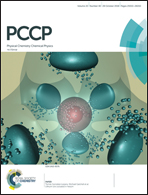Electric-field control of non-volatile 180° switching of the unidirectional anisotropy field in a multiferroic heterostructure†
Abstract
We investigate the room-temperature, electric-field-mediated, non-volatile 180° switching of the unidirectional anisotropy field in an IrMn/CoFeB/Ta/Pb(Mg1/3Nb2/3)O3–PbTiO3 heterostructure. The variation in exchange bias under different electric fields appears clearly in the magnetic hysteresis loops. The remnant magnetization as a function of electric field, as determined by static magnetic measurements, exhibits a non-volatile behavior, which is consistent with the results of the ferromagnetic resonance field as a function of electric field. Moreover, the measured ferromagnetic resonance shows that the uniaxial magnetic anisotropy field is non-volatile and the unidirectional anisotropy field undergoes 180° switching that can be acquired and separated distinctly. This result is attributed to the piezo-strain effect. The electric-field-mediated non-volatile 180° switching of the unidirectional anisotropy field paves the way for sensors and other spintronic devices.



 Please wait while we load your content...
Please wait while we load your content...